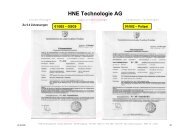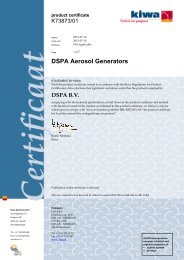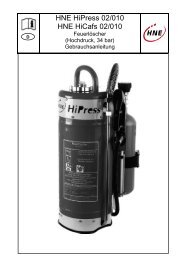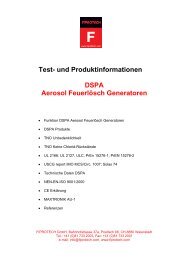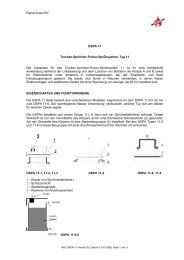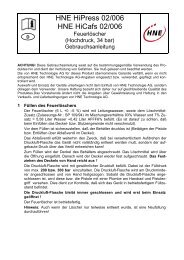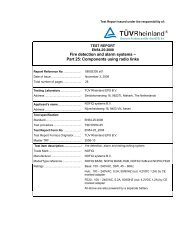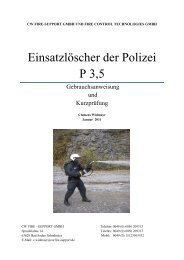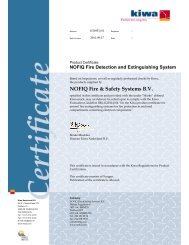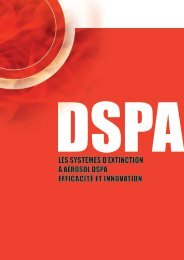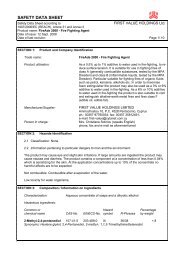FireAde 2000 Hydrocarbon suspension technology - Flame Guard
FireAde 2000 Hydrocarbon suspension technology - Flame Guard
FireAde 2000 Hydrocarbon suspension technology - Flame Guard
You also want an ePaper? Increase the reach of your titles
YUMPU automatically turns print PDFs into web optimized ePapers that Google loves.
The new <strong>technology</strong><br />
for fighting fires<br />
Non-toxic<br />
Non-corrosive<br />
Frost resistant down to –32° C<br />
Biodegradable<br />
Extreme heat<br />
dissipating capabilities<br />
Fire class A/B<br />
Fire class D/F<br />
Stable foam, free of fluorine<br />
Eliminates flammable liquids<br />
Heavy consistency foam<br />
with hollow spray head<br />
Much less consumption of water<br />
and extinguishing agent<br />
Submission of the<br />
free radicals<br />
Less smoke,<br />
improved visibility<br />
Increased safety<br />
for fire fighters<br />
<strong>FireAde</strong> <strong>2000</strong><br />
<strong>Hydrocarbon</strong><br />
<strong>suspension</strong> <strong>technology</strong><br />
®
2<br />
®<br />
OVERVIEW<br />
<strong>FireAde</strong> <strong>2000</strong> is based on high-tech chemistry with<br />
properties that are uniquely suitable for fighting and<br />
preventing fires. <strong>FireAde</strong> <strong>2000</strong> was developed by<br />
US scientists and patented as a superior alternative<br />
to conventional, foam-based extinguishing agents.<br />
<strong>FireAde</strong> <strong>2000</strong> is a development by one of the pioneers<br />
in the field of fire fighting, Mr Ron Thames,<br />
who previously became famous during the fires of<br />
Kuwaiti and the Gulf fires.<br />
Among other applications, <strong>FireAde</strong> <strong>2000</strong> is being<br />
used by American aircraft carriers and refineries in<br />
the Near and Middle East and has now also been<br />
approved in Europe. It provides a new <strong>technology</strong><br />
that offers increased safety for the fire-fighting<br />
crews, while at the same time permanently extinguishing<br />
the fire at various levels with a previously<br />
unknown degree of efficiency.<br />
In the fire classes A, B and F, <strong>FireAde</strong> <strong>2000</strong> can also<br />
be used in sections of fire class D (alkaline earth<br />
metals) and does not have the disadvantages of<br />
conventional foam extinguishing agents, which<br />
also include poisonous fluorine compounds.<br />
<strong>FireAde</strong> <strong>2000</strong> is biodegradable, non-corrosive and<br />
facilitates the immediate dissipation of heat from<br />
the burning material by combining a number of<br />
Fire Services Plus: “Here at Fire<br />
Service Plus we are committed<br />
to saving human lives and protecting<br />
our environment by developing<br />
and producing an environmentally<br />
compatible extinguishing<br />
agent.<br />
Fire Services Plus is one of the world’s fastest growing<br />
producers of fire-extinguishing agents and has 30<br />
years of experience in research and development that<br />
has made a success of an innovative and environmentally<br />
compatible <strong>technology</strong>. Our <strong>FireAde</strong> <strong>2000</strong> products<br />
set new standards. We do not fight fires - we<br />
extinguish them.<br />
The registered address of Fire Service Plus is in<br />
Fayetteville, Georgia, USA. Fire Service Plus employs a<br />
professional team with decades of experience in the<br />
sale of extinguishing agents to governments, local<br />
authorities and industry. Our business is known<br />
worldwide for its high degree of integrity in the production<br />
of <strong>FireAde</strong> products.<br />
Our <strong>FireAde</strong> products have set a standard; they are<br />
suitable for a wide range of applications, are not<br />
hazardous or toxic and are biodegradable. These<br />
characteristics render <strong>FireAde</strong> <strong>2000</strong> very effective and<br />
universally useful. <strong>FireAde</strong> products are used in many<br />
countries for military, industrial and fire-fighting applications.<br />
The agent for all types of applications: <strong>FireAde</strong> <strong>2000</strong><br />
different operating mechanisms with previously<br />
unknown efficiency. The new <strong>technology</strong> for separating<br />
the hydrocarbon molecules on a molecular basis<br />
neutralises flammable liquids; even explosive liquids<br />
are extinguished immediately after wetting which in<br />
turn largely prevents the reignition effect. An additional,<br />
stable foam film that floats on a membrane<br />
also reliably separates the oxygen from the burning<br />
material and the flammable vapours.<br />
The new extinguishing agent in fire fighting – a profile of<br />
the pioneer Ron Thames and his company, Fire Services Plus<br />
We have combined various technologies that were<br />
not previously compatible in the history of extinguishing<br />
foams, i.e. Class A extinguishing agents, Class B<br />
extinguishing agents and wetting agents. This revolutionary<br />
breakthrough is possible with <strong>FireAde</strong> <strong>2000</strong>.<br />
Class A extinguishing agents are exactly what they<br />
profess to be: extinguishing agents only for Class A<br />
fires. The extinguishing agent industry only recognises<br />
wetting agents as non-foaming agents. These<br />
products work on a different chemical basis from the<br />
AFFF media (aqueous film foaming foams). Wetting<br />
agents are thus typically used for Class A fires and<br />
rarely for flammable liquids, due to the missing foam<br />
component.<br />
Foam and AFFF products are generally considered to<br />
be standard agents and serve as the “extinguishing<br />
foam” for fire-fighting purposes. AFFF products cover<br />
the fire to be extinguished with a film that generates<br />
a membrane, which in turn suppresses toxic vapours<br />
and the fire itself. AFFF products are normally only<br />
used for fires in class B.<br />
Their combination has resulted in the unique characteristics<br />
of <strong>FireAde</strong> <strong>2000</strong>. Fire Service Plus has combined<br />
the “wetting agent <strong>technology</strong>” with the “AFFF”<br />
<strong>technology</strong>. This has resulted in the first multidimensional<br />
extinguishing agent in classes A and B.<br />
<strong>FireAde</strong> <strong>2000</strong> reliably extinguishes almost any kind of<br />
fire.”
The new <strong>technology</strong> for fighting fires, toxic vapours and contamination<br />
<strong>FireAde</strong> <strong>2000</strong> does not require any special equipment<br />
and can be used by the fire brigade together<br />
with standard equipment such as a hollow spray<br />
head, a heavy- and medium-consistency foam pipe<br />
and existing mixing systems.<br />
Due to its low viscosity (dry matter < 5%), <strong>FireAde</strong><br />
<strong>2000</strong> also immediately mixes with the extinguishing<br />
water and remains mixed. There is no risk of extinguishing<br />
systems becoming blocked or not permanently<br />
achieving the desired concentration. Valves<br />
and pumps also do not have to be maintained after<br />
use, as the product is non-corrosive, just flush with<br />
fresh water.<br />
Traditional fire-fighting methods disperse heat by<br />
converting water into water vapour or by removing<br />
oxygen from the fire as one of the elements of<br />
the fire tetrahedron, as well as by temporarily<br />
covering toxic vapours with a foam film (foam<br />
for fire class B).<br />
The molecular structure of <strong>FireAde</strong> <strong>2000</strong>, on the<br />
other hand, forms the basis for a new fire-fighting<br />
method, which simultaneously acts on heat, fuel,<br />
oxygen and free radicals as parameters of the fire<br />
tetrahedron model. It is therefore the ideal medium<br />
for fighting fires and neutralising easily flammable<br />
liquids.<br />
Accreditations and approvals<br />
US Defence Ministry<br />
UL accreditation<br />
MPA Dresden (European accreditation)<br />
Hygiene Institute for the Ruhr region<br />
At an admixing rate of 1%, 3% and 6%, <strong>FireAde</strong><br />
<strong>2000</strong> was approved for applications in fire classes<br />
A and B, both according to the United States and<br />
the Canadian standards of the UL certification<br />
organisation.<br />
<strong>FireAde</strong> <strong>2000</strong> is available in two variants:<br />
<strong>FireAde</strong> <strong>2000</strong> Fire Fighting Agent<br />
frost resistant down to – 4 Grad Celsius<br />
<strong>FireAde</strong> <strong>2000</strong> Climate Control<br />
frost resistant down to – 32 Grad Celsius.<br />
The results confirm that <strong>FireAde</strong> <strong>2000</strong> corresponds<br />
to the current requirements of the UL 162 standards<br />
for foam extinguishing agents, as well as the NFPA<br />
18 standards for wetting agents.<br />
Note: Fire Services Plus Inc. does not in any way advocate the<br />
improper disposal of neutralised, spilled fuels. Guidelines for<br />
appropriate disposal are available from your local council or from<br />
the relevant government authorities.<br />
3<br />
®
4<br />
APPLICATIONS<br />
Fire fighting<br />
®<br />
The chemistry of fire<br />
A basic chemical knowledge of fire is a precondition<br />
for understanding how a fire-fighting agent acts on<br />
the fire.<br />
From an historical point of view, the chemistry of fire<br />
is based on the model of the fire tetrahedron.<br />
A fourth factor, the so-called free radicals, were identified<br />
at the beginning of the 1980s. It is since then<br />
®<br />
The agent for all types of applications: <strong>FireAde</strong> <strong>2000</strong><br />
known that fire chemistry is based on the extended<br />
fire tetrahedron model, which consists of the parameters<br />
of oxygen, fuel, heat and free radicals.<br />
Lately, the free radicals have been given increased<br />
significance. All four factors of the fire tetrahedron<br />
must be present for a fire to spread.<br />
Applications in fire class A Wood Coal Paper Coconut Cotton<br />
Fibre glass Hay / Straw / Crops Rubber tyres<br />
Applications in fire class B Isopropyl alcohol Ethanol E-85 Methanol<br />
[polar] Methylethylketon Methyl tertiary butyl ether<br />
Applications in fire class B Petrol Diesel Jet A (kerosene) military fuels /<br />
JP5 / JP8 Crude oils<br />
[non-polar]<br />
Applications in parts of Alkaline earth metals such as magnesium, titanium,<br />
fire class D aluminium, etc.
The new <strong>technology</strong> for fighting fires, toxic vapours and contamination<br />
The absorption of spilled liquids<br />
Flammable hydrocarbon liquids are neutralised by<br />
using a 3% admixing rate.<br />
This opens up the following fields of application:<br />
Neutralisation of spilled fuel<br />
Neutralisation of spilled liquids in refineries, in<br />
the chemical and industrial areas<br />
Neutralisation of fuels in drainage pits<br />
One of the most significant advantages of<br />
<strong>FireAde</strong> <strong>2000</strong> over conventional foam is that<br />
the fuel remains neutralised during the cleaning<br />
phase and the subsequent disposal of the<br />
hazardous substances.<br />
FIRE-FIGHTING<br />
METHODS<br />
A fire is extinguished by removing one of the factors<br />
of the expanded fire tetrahedron model. There are<br />
basic differences between the fire-extinguishing<br />
methods using wetting agents (NFPA 18), foam<br />
in fire classes A and B (NFPA P 1150 or NFPA P 11)<br />
and the fire-fighting method using separation, for<br />
example the chemical medium <strong>FireAde</strong> <strong>2000</strong> (new<br />
NFPA project). These basic differences are explained<br />
below:<br />
Wetting agent<br />
The method of fighting fires with the aid of wetting<br />
agents is based on one main operating principle:<br />
1. Reducing the surface tension<br />
The surface tension of the water is reduced from 72<br />
dyn/cm 2 to less than 22 to 26 dyn/cm 2 .<br />
This reduced surface tension has several decisive<br />
advantages over normal water during fire fighting.<br />
By reducing the surface tension, the size of the<br />
individual water droplets is reduced. The heat of<br />
Normal water: The diagram illustrates how the expansion<br />
capacity of the water is limited by its high surface tension<br />
(72 dyn/cm_), with bridges being formed via the pores, which<br />
in turn prevents water penetration.<br />
a fire is reduced by the fact that the energy is mainly<br />
absorbed by changing the state from liquid to gas.<br />
Small water droplets result in a larger surface area<br />
relative to the volume, which means that the fire<br />
comes into contact with a larger water surface, thus<br />
increasing the conversion of water into water<br />
vapour.<br />
In addition, the water is distributed more rapidly as<br />
a result of the reduced surface tension, so that it<br />
can penetrate deeper into the pores and the<br />
burning material.<br />
Note: Wetting agents cannot form foam films or separate Hydro<br />
Carbon molecules.<br />
Wetting agent: The diagram shows how the surface tension<br />
is reduced by the wetting agent, so that a larger surface is<br />
covered and the water can penetrate the pores of the<br />
thermal loads.<br />
5<br />
®
6<br />
®<br />
Foams in fire classes A and B<br />
The foam method of fighting a fire is based on two<br />
operating principles:<br />
1. Reducing the surface tension<br />
As is the case with the wetting agents, foam also<br />
reduces the surface tension of the water. This<br />
characteristic supports the formation of bubbles and<br />
the expansion of the foam film over the surface of<br />
the thermal load.<br />
The technically mature alternative<br />
<strong>FireAde</strong> <strong>2000</strong> – fighting fires<br />
with <strong>suspension</strong> <strong>technology</strong><br />
The method of fighting fires by separation is based<br />
on five basic operating principles:<br />
1 Reducing the surface tension of the water<br />
2 Rapid heat reduction<br />
3 Interrupting the chain reaction<br />
of the free radicals<br />
4 Formation of a foam film<br />
5 Neutralisation of the Hydro Carbon molecules<br />
On 1) Reducing the surface tension of the water<br />
As is the case with the wetting agent, the surface<br />
tension of the water is reduced from 72 dyn/cm 2<br />
to less than 22 to 26 dyn/cm 2 , depending on the<br />
water used. During fire fighting, this effect has the<br />
same advantages as the use of a wetting agent in<br />
comparison with ordinary water.<br />
By reducing the surface tension, the size of the<br />
individual water droplets is reduced. A smaller water<br />
droplet size means a larger surface area relative to<br />
the volume. Heat dissipation is achieved by allowing<br />
the fire to come into contact with the water surface<br />
and removing energy by changing the state from<br />
liquid to gas.<br />
A larger surface area in proportion to the volume<br />
enables greater contact with the fire so that thermal<br />
energy is more rapidly absorbed even if the water<br />
volume remains constant. <strong>FireAde</strong> <strong>2000</strong> chemically<br />
reacts with the water, causing normal water to<br />
become up to 15 times “softer“, with the individual<br />
droplets becoming significantly smaller. The surface<br />
tension is significantly reduced.<br />
In addition, the water can be distributed more<br />
rapidly due to the reduced surface tension, so that a<br />
greater surface is dampened and the water can<br />
penetrate more deeply into the burning material.<br />
On 2) Rapid heat reduction<br />
Fire Ade <strong>2000</strong> improves the way in which the heat is<br />
channelled into the water droplets, thus resulting in<br />
The agent for all types of applications: <strong>FireAde</strong> <strong>2000</strong><br />
2. The formation and maintenance of a foam film<br />
The distinctive difference with wetting agents lies in<br />
the fact that foam is able to form bubbles that last<br />
longer (i.e. formation of a foam film over the<br />
thermal load). This isolates the thermal load from<br />
oxygen, cutting off the supply of oxygen required<br />
for the fire to burn.<br />
The covering capacity of the foams in fire classes A<br />
and B isolates the thermal load, which subsequently<br />
emits heat at a slower rate.<br />
Surface tension test<br />
According to US norm NFPA 18<br />
<strong>FireAde</strong> <strong>2000</strong> fulfils all the NFPA 18 directives for<br />
tests for class A and class B fires.<br />
Practical tests<br />
A simple test demonstrates how <strong>FireAde</strong> <strong>2000</strong><br />
improves the wetting and penetration capacity of<br />
water.<br />
10 cm 3 water are applied to blotting paper in a<br />
fixed position. The surface tension causes it to<br />
form a pool of approximately 50 mm 2 .<br />
When a 3% mixture of water and <strong>FireAde</strong> <strong>2000</strong> is<br />
used and 10 cm 3 water are applied in the same way,<br />
the surface tension of the water is reduced to such<br />
an extent that the dampened surface immediately<br />
expands to more than 600 mm 2 as the smaller<br />
droplet size causes the mixture to penetrate the<br />
paper instead of forming a pool.<br />
a significantly higher evaporation rate. In addition,<br />
existing Hydro Carbon molecules are attracted to<br />
this <strong>FireAde</strong> <strong>2000</strong> / water compound by its electrical<br />
charge. These characteristics of the <strong>FireAde</strong> <strong>2000</strong> /<br />
water mixture result in the mixture being almost<br />
entirely converted into water vapour which produces<br />
a very great cooling effect. These water vapour<br />
molecules combine with the adjoining water<br />
molecules and the water vapour condenses back<br />
into water. This cyclical change in the state within<br />
the water droplet, i.e. between evaporation and<br />
condensation, absorbs a great deal of heat energy,<br />
thus rapidly reducing the heat while at the same<br />
time creating little water vapour.<br />
In addition to the reduced surface tension, and thus<br />
to the increase in the surface/volume ratio, the
The new <strong>technology</strong> for fighting fires, toxic vapours and contamination<br />
<strong>FireAde</strong> <strong>2000</strong> allows for the absorption of about ten times as much heat energy as ordinary water.<br />
covalent ends of the <strong>FireAde</strong> <strong>2000</strong> molecules project<br />
from the water droplets. The all-round channelling<br />
of heat into the droplets prevents the droplets from<br />
”shooting off“ as a result of asymmetrical water<br />
vapour formation when they are heated from one<br />
side only.<br />
The droplets of the <strong>FireAde</strong> <strong>2000</strong>/water mixture<br />
look like pin-cushions with projecting pins. As these<br />
droplets come closer to a fire, the <strong>FireAde</strong> <strong>2000</strong><br />
molecule acts as a heat conductor that channels the<br />
heat to the inside of the droplet.<br />
<strong>FireAde</strong> <strong>2000</strong> was developed in such a way that not<br />
only the outer surface of the water droplets but also<br />
their inner volume is effectively used. The following<br />
could be proven, both during experimental studies<br />
and during design calculations:<br />
<strong>FireAde</strong> <strong>2000</strong> allows for the absorption of about<br />
ten times as much energy as ordinary water.<br />
Heat reduction using <strong>FireAde</strong> <strong>2000</strong> is more<br />
efficient than using of foam, which isolates<br />
the thermal load.<br />
Temperature reduction<br />
Method in comparison to AFFF foam<br />
This test shows the marked difference in the<br />
cooling efficiency between <strong>FireAde</strong> <strong>2000</strong> and<br />
traditional foam.<br />
The test objects were two steel plates with a thickness<br />
of 2 cm and an edge length of 15 cm. Both<br />
plates were continuously exposed to a extinguishing<br />
stream. The initial temperature was over 600<br />
degrees centigrade. The test period amounted to<br />
60 seconds of cooling. Immediately after this<br />
period, the plate cooled with <strong>FireAde</strong> <strong>2000</strong> had<br />
a temperature that prevented reignition.<br />
Foam cooled the plate far more slowly and a<br />
significantly greater amount of cooling liquid<br />
was required.<br />
Unlike the foam in fire class B, which isolates the<br />
thermal load, <strong>FireAde</strong> <strong>2000</strong> rapidly reduces the<br />
temperature of the thermal load (as well as of the<br />
adjoining infrastructure) to below the self-ignition<br />
temperature. A very short extinguishing time is<br />
achieved in combination with the foam film.<br />
The rapid heat reduction of <strong>FireAde</strong> <strong>2000</strong>, together<br />
with its separation effect, considerably reduces<br />
spontaneous reignition, as the vapours are separated,<br />
while simultaneously rapidly reducing the<br />
temperatures to below the self-ignition temperature.<br />
When simulating ”flash over“, the fire fighters<br />
usually crouch down in the vicinity of the simulator.<br />
Burns may occur as a result of the considerable<br />
formation of water vapour. When simulating "flash<br />
over" situations, the use of <strong>FireAde</strong> <strong>2000</strong> leads to a<br />
low risk of burns as a result of its rapid cooling and<br />
minimal water vapour formation effect.<br />
600° C<br />
500° C<br />
400° C<br />
300° C<br />
200° C<br />
100° C<br />
0° C<br />
AFFF foam<br />
<strong>FireAde</strong> <strong>2000</strong><br />
0 10 20 30 40 50 60<br />
seconds<br />
7<br />
®
8<br />
®<br />
Smoke reduction when using <strong>FireAde</strong> <strong>2000</strong><br />
On 3) Interrupting the chain reaction<br />
of the free radicals<br />
Free radicals are uncharged molecular components<br />
with high reactivity. They collide with fuel sources in<br />
Class A or B at high speed. This causes heat and<br />
even more free radicals to be released, triggering a<br />
chain reaction which in turn accelerates the<br />
combustion process. Due to its high molecular mass,<br />
<strong>FireAde</strong> <strong>2000</strong> inhibits the radical chain reaction by<br />
The agent for all types of applications: <strong>FireAde</strong> <strong>2000</strong><br />
For the fire-fighting crew, good visibility has a major safety advantage, resulting in a lower risk to human life<br />
and property.<br />
The diagrams show that smoke development is significantly suppressed immediately after using <strong>FireAde</strong> <strong>2000</strong>,<br />
even more strongly in the case of flammable liquids than for Class A fires, where smoke development was<br />
reduced by almost half. In the case of petrol and diesel fires, the application of <strong>FireAde</strong> <strong>2000</strong> as a 3% additive<br />
almost entirely eliminated the reduction in visibility caused by smoke after about 30 seconds.<br />
<strong>FireAde</strong> <strong>2000</strong> not only accelerates the improvement in visibility but also combats the formation of toxic<br />
substances often found in dense smoke.<br />
100%<br />
80%<br />
60%<br />
40%<br />
20%<br />
0%<br />
Smoke reduction<br />
(Class A fire)<br />
94%<br />
52%<br />
before after<br />
Smoke reduction<br />
(Petrol and Diesel fire)<br />
99%<br />
100%<br />
80%<br />
60%<br />
40%<br />
20%<br />
absorbing the energy of the free radicals released<br />
during these collisions and channelling it into the<br />
water.<br />
As the energy of the combustion system decreases<br />
as a result of the absorption of the high energy<br />
from the free radicals, the fire is extinguished.<br />
When the free radicals collide, soot and smoke are<br />
formed. In fact, soot is the third purest form of<br />
carbon.<br />
Biochemical and chemical oxygen consumption (BOD and COD)<br />
Oxygen consumption is a<br />
standardised measure for determining<br />
the degree of contamination<br />
of water reserves, especially in the<br />
case of polluted waste water or<br />
industrial waste.<br />
Chemical oxygen consumption<br />
refers to the amount of oxygen,<br />
in particles per million (ppm),<br />
that can be measured during the<br />
oxidation of organic material in<br />
the waste water.<br />
<strong>FireAde</strong> <strong>2000</strong> is fully biologically<br />
degradable and the results shown<br />
in the diagram show that <strong>FireAde</strong><br />
<strong>2000</strong> is far less harmful to the<br />
environment than traditional foam.<br />
mg/l<br />
300<br />
250<br />
200<br />
150<br />
100<br />
50<br />
0<br />
COD<br />
BOD<br />
93<br />
0%<br />
297<br />
1%<br />
before after<br />
<strong>FireAde</strong> <strong>2000</strong><br />
in comparison<br />
to AFFF foam –<br />
the difference<br />
is obvious.<br />
3% AFFF foam 3% <strong>FireAde</strong> <strong>2000</strong><br />
1<br />
7
The new <strong>technology</strong> for fighting fires, toxic vapours and contamination<br />
By admixing of 3% of <strong>FireAde</strong> <strong>2000</strong> heat is instantly being dissipated and the surface of combustible liquids is being separated by<br />
the <strong>FireAde</strong> <strong>2000</strong> molecules. After the dissipation of heat and the separation of the Hydro Carbon molecules a thick membrane and<br />
a tight structure (no large bubbles) foam blanket is built.<br />
<strong>FireAde</strong> <strong>2000</strong> interrupts the chain reaction of the<br />
free radicals by strongly reducing the collision with<br />
new thermal loads.<br />
The prevention of radical reactions by reducing the<br />
smoke was determined before, during and after the<br />
application of <strong>FireAde</strong> <strong>2000</strong>.<br />
On 4) Formation of a foam film<br />
Moreover, <strong>FireAde</strong> <strong>2000</strong> is designed to build a heavy<br />
or medium consistency foam. In case of heavy consistency<br />
foam one can choose between a hollow<br />
spray pipe or a heavy foam pipe. The crews can act<br />
more flexible with the hollow spray pipe. <strong>FireAde</strong><br />
<strong>2000</strong> develops a very stable and dense foam blanket<br />
which does not exceed 3 cm in height in case of<br />
heavy consistency foam.<br />
The foam blanket is floating on a thick membrane,<br />
which also separates the oxygene from the burning<br />
material and combustible vapours<br />
On 5) Separation of the Hydro Carbon molecules<br />
As soon as the <strong>FireAde</strong> <strong>2000</strong> / water mixture comes<br />
into contact with hydrocarbon molecules, a new<br />
chemical reaction takes place. This provides the<br />
Hydro Carbon molecular groups on the surface with<br />
a negative charge, causing them to repel each other.<br />
At the same time, they attract the positively charged<br />
water, so that they are separated from each other<br />
but surrounded by water, which they retain.<br />
9<br />
®
10<br />
®<br />
As is shown in the diagram on the right, the<br />
chemistry of <strong>FireAde</strong> <strong>2000</strong>, by changing the<br />
electrical charge, ensures that the Hydro Carbon<br />
molecular groups repel each other and thus separate<br />
and attract the surrounding water, not allowing any<br />
flammable Hydro Carbon vapours to be formed.<br />
This new approach to the molecular separation<br />
of the fuel has numerous advantages for the firefighting<br />
crews. The <strong>FireAde</strong> <strong>2000</strong> chemistry separates<br />
the fuel in a liquid state and binds it with water,<br />
thus resulting in the liquids no longer being<br />
flammable and explosive.<br />
Five litres of burning cooking oil: even self-combustible edible fats and thermic oils<br />
are reliably extinguished by a ten percent admixture of <strong>FireAde</strong> <strong>2000</strong>.<br />
The agent for all types of applications: <strong>FireAde</strong> <strong>2000</strong><br />
Groups of Hydro Carbon molecules separated by <strong>FireAde</strong> <strong>2000</strong>
The new <strong>technology</strong> for fighting fires, toxic vapours and contamination<br />
Applications of <strong>FireAde</strong> <strong>2000</strong><br />
Practical fire-extinguishing tests with <strong>FireAde</strong> <strong>2000</strong><br />
A large number of tests were carried out with numerous fires. Two examples are given below:<br />
Transformer fire<br />
A major American energy generator carried out<br />
tests on transformers with a cooling liquid<br />
volume of 40,000 litres of hydraulic oil. These<br />
tests compared the extinguishing effect of<br />
<strong>FireAde</strong> <strong>2000</strong> and AFFF foam.<br />
The heat emanating from the fire was so intense<br />
that five crews had problems applying a foam<br />
film before it evaporated. During the AFFF foam<br />
test, five groups had to spray foam continuously<br />
at the site of the fire for a period of more than<br />
12 hours before the fire had been completely<br />
extinguished.<br />
After applying <strong>FireAde</strong> <strong>2000</strong> for only 30 minutes,<br />
the heat sensors showed a temperature drop of<br />
426 degrees and the crew could be withdrawn<br />
after only 40 minutes.<br />
In both cases, the original explosion completely<br />
destroyed the transformers.<br />
Brushwod fire<br />
These tests were carried out by fully qualified<br />
members of a voluntary fire brigade in the USA.<br />
Approximately 4 hectares of dry brushwood were<br />
set alight under controlled conditions to obtain a<br />
comparison between <strong>FireAde</strong> <strong>2000</strong> and AFFF<br />
foam.<br />
Transformer fire <strong>FireAde</strong> <strong>2000</strong> AFFF foam<br />
Total time spent at site < 40 minutes 12.5 hours<br />
Total consumption of 38 litres 470 litres<br />
extinguishing agent<br />
Actual time until fire 1 minute, 28 minutes<br />
is extinguished 24 seconds<br />
Labour costs $ 250 for a $ 5,200 for a<br />
two-man crew four-man crew<br />
Brushwood fire <strong>FireAde</strong> <strong>2000</strong> AFFF foam<br />
Admixing rate 0.25 % 1.0 %<br />
Water consumption 860 litres 8.140 litres<br />
Product consumption 3.7 litrs 83 litres<br />
Manpower and Two-man crew Four-man crew<br />
hardware 1 tanker vehicle 2 tanker vehicles<br />
1 water storage<br />
tanker<br />
Total time spent at site 28 minutes 4.5 hours<br />
11<br />
®
12<br />
®<br />
EUROPA<br />
Fire Services GmbH<br />
Hallplatz 15<br />
D-90402 Nuremberg<br />
Telefon: +49 (0) 911-234299-0<br />
Telefax: +49 (0) 911-234299-55<br />
Website: www.fireservices.de<br />
E-Mail: info@fireservices.de<br />
USA<br />
Fire Services Plus Inc.<br />
180 Etowah Trace<br />
Fayetteville, Georgia 30214, USA<br />
The agent for all types of applications: <strong>FireAde</strong> <strong>2000</strong><br />
THE CONTENT OF THIS BROCHURE DOES NOT PRO-<br />
VIDE THE READER OR BUYER WITH ANY WARRANTY<br />
OR CONSTITUTE ANY ACCEPTANCE OF LEGAL LIABI-<br />
LITY, INCLUDING - BUT NOT RESTRICTED - TO A<br />
WARRANTY CONCERNING THE MARKETABILITY OR<br />
THE SUITABILITY OF THE PRODUCT FOR A SPECIFIC<br />
APPLICATION.<br />
The specifications and information provided on the<br />
mechanical and physical characteristics or chemical<br />
analyses refer only to the chemical analysis of samples<br />
taken from substances at specific sites when manufacturing<br />
the products, in accordance with the regulations<br />
governing sampling. Documentation about<br />
the exact sales and delivery conditions is available<br />
from Fire Services GmbH.




